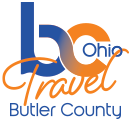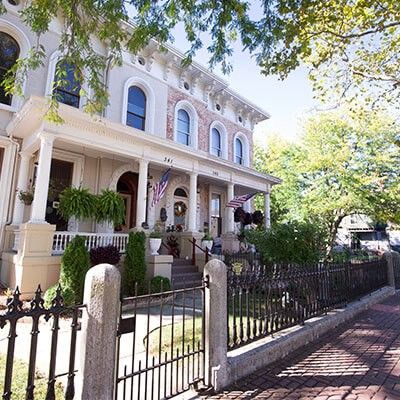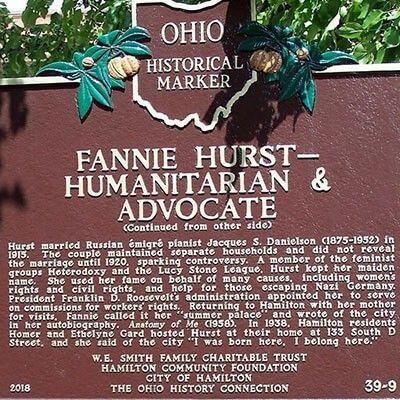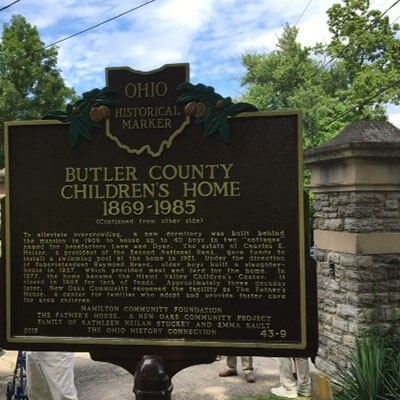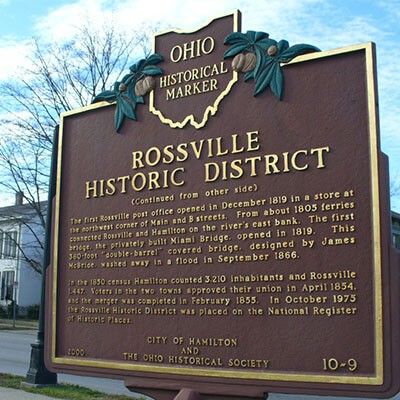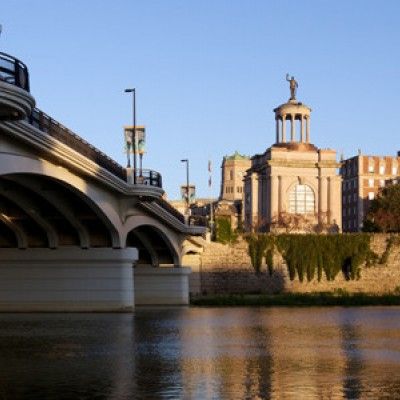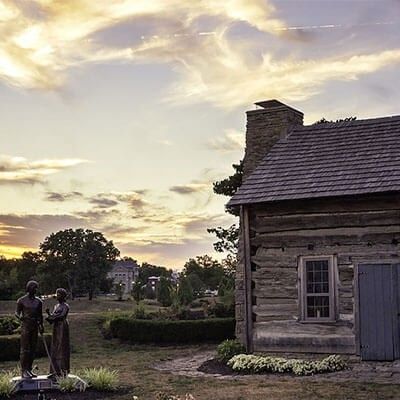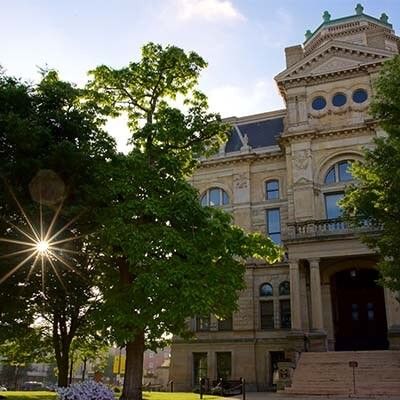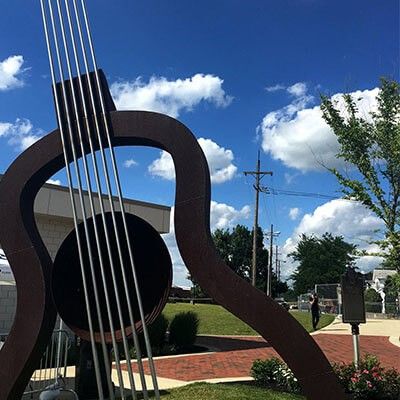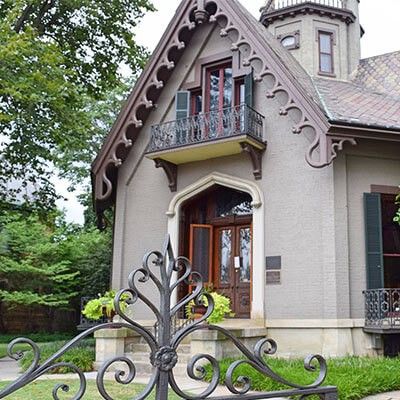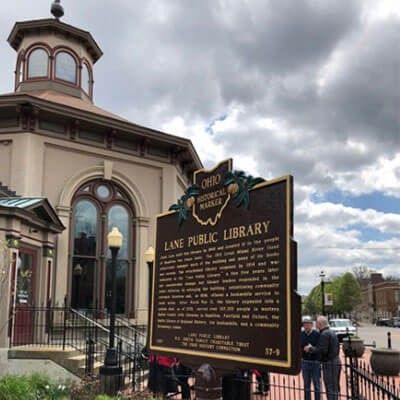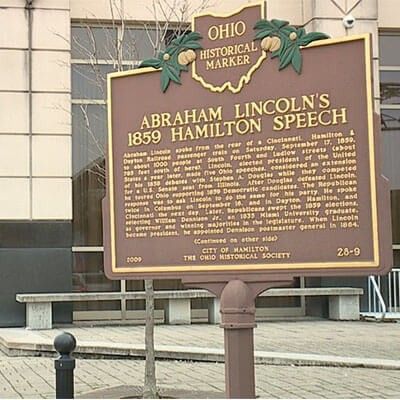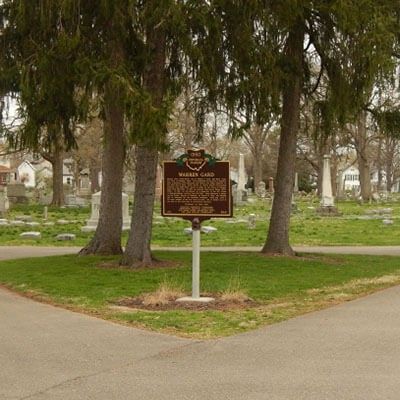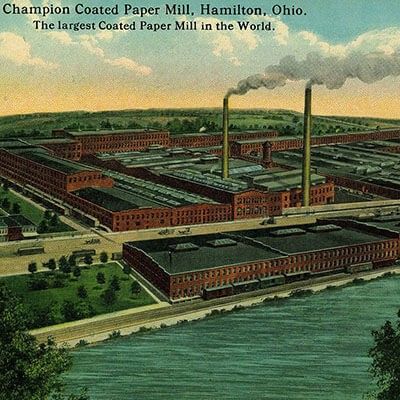Looking to spend a day in Butler County that is not only fun for you and the kids, but also educational? The Butler County Historical Society has put together this Historical Driving Tour that is a perfect opportunity to get out, have a blast, and learn all about the incredible history of Hamilton, Ohio! From historical events, to major historical figures, to incredible sculptures, art and architecture... you'll be surprised just how much there is to learn about Hamilton.
The tour is complete with 12 Stops, each accompanied by an Ohio Historical Marker, and the tour is designed to be self-guided. Below we have outlined each stop with our own fun-facts as well as directions and other quick stops to make along the way!
The Butler County Historical Society | 327 N. 2nd Street, Hamilton OH
View the Butler County Historical Society's Tour Outline here!
Stop 1: Fannie Hurst
Armistead Park | 305 Main St. Hamilton, OH
Photo Credit : Historical Marker Database
Stop number one on your driving tour will take you to learn more about the famous author, humanitarian, advocate, and Hamilton native, Fannie Hurst. As a woman in the 1900s, Fannie faced a lot of rejection before she finally found success in the mid 1920s. Fannie published her autobiography, Anatomy of Me, in 1958 and mentions Hamilton numerous times, referring to her hometown as her Summer Palace. Learn more about Fannie and her life-long work at this stop... and while you're there, you might as well check out the vibrant Alexander Hamilton Mural and stop by True West Coffee's drive-thru for a refreshment!
Directions to Stop 2: Turn right (north) on South D Street
Stop 2: The Children's Home
425 S. D Street, Hamilton OH
Photo Credit : Remarkable Ohio
Stop number 2 is full of history — the Butler County Children's Home first began in 1869, when a group of women wanted to help the many children that were left orphaned and impoverished due to the Civil War. At this stop you can learn the entire history of the home and the people who worked to upkeep it and the mission. Today, the house is home to The Father's House, a center for families who adopt and provide foster care for area children, ran by the non-profit New Oaks Community.
Directions to Stop 3: Turn around and go south on South D to Ross Avenue. Turn right.
Stop 3: Rossville Historic District
SE Corner of Ross Ave & S. B Street, Hamilton OH
Photo Credit : Remarkable Ohio
Here at Stop 3, you'll learn about the settlement of Rossville which began all the way back in 1801 and the town was then founded in 1804. Much of the town's history is intertwined with the history of the Great Miami River. Rossville was actually named in honor of Pennsylvania Senator James Ross (1762-1847), who favored Ohio statehood and advocated free navigation of inland rivers.
Directions to Stop 4: Leave parking lot, turn right on Western Drive, then right on Patterson Avenue. Stay on Patterson Avenue (U.S. 27) through the intersection of Patterson and Spring Street. Bishop Circle will be on the left. Turn left at the second (northern) entrance to Bishop Circle and proceed. The marker will be on the left, at the edge of Bishop Woods, on the curve in the drive.
Stop 4: Soldiers, Sailors & Pioneers Monument
1 S. Monument Street, Hamilton OH
This stop will lead you to one of the better known monuments in Downtown Hamilton. The Soldiers, Sailors, and Pioneers Monument was planned and promoted by Butler County Civil War veterans and financed by a county levy in 1899. Here you can stop at the monument to learn more about Fort Hamilton, the contributions of Butler County women during the Civil War, and Veteran names carved into the interior marble walls.
Fun Fact: The statue atop the monument is officially entitled "Victory, the Jewel of the Soul," but is better known as "Billy Yank"
Directions to Stop 5: Continue down S Monument Ave towards the Fitton Center for Creative Arts to park there or in Lentil Park.
Stop 5: William Dean Howells
Historic Log Cabin | S. Monument Street, Hamilton OH
Photo Credit : Mckenzie Snyder
Author William Dean Howells spent his boyhood from 1840 to 1848 in Hamilton, and his historical marker is located near the Historic Log Cabin. At this stop, you can learn more about Howells impact on future writers in literature, as well as in the newspaper industry. There are also an abundance of other sculptures, sightseeing opportunities and history lessons for you to enjoy in the area!
Directions to Stop 6: Continue south on Monument to the first intersection: Court Street. Turn left (east) on Court. Go one block and turn left (north) on Front Street. Go one block and turn right (east) on High Street. The marker is in the middle of the block on your right.
Stop 6: The Butler County Courthouse
101 High Street, Hamilton OH
Did you know that Butler County was founded on March 24th, 1803 — just about three weeks after Ohio became a state? Hamilton won the competition for the county seat and The Courthouse was built here in 1810. Stop 6 is your opportunity to engage in the history of Butler County as well as the Courthouse and its structural history.
Directions to Stop 7: Continue east on High Street to Second Street, turn left. Proceed on North Second to Dayton. Turn left. The marker is in RiversEdge Park at the end of Dayton. It is on your left by the guitar.
Stop 7: Johnny Black
116 Dayton Street, Hamilton OH
Stop 7 is dedicated to performer and songwriter, John Stewart Black, who penned the classic song Paper Doll in the year 1915 and it became one of the most memorable records of the World War II era. Many artists, including Frank Sinatra and Bing Crosby, recorded Paper Doll and the song was inducted into the Grammy Hall of Fame in 1998. Johnny Black's historical marker and the guitar sculpture are located in RiversEdge at Marcum Park, which is a great place for additional sightseeing opportunities or a place to relax a bit before your next stop!
Directions to Stop 8: At the intersection of Dayton and Riverfront (at the Great Miami River) turn right (north). Stay on Riverfront to Village Street (T intersection) and turn right. Stay on Village to North 3rd Street. Turn right (south) on Third. Both markers are across the street from each other.
Stop 8: Lane-Hooven House
319 N. Third Street, Hamilton OH
Stop 8 takes you to this octagonal house, which is one of only 400 in the United States! James Elrick, a local carpenter, built the Lane-Hooven House in 1863 for Clark Lane who was a Hamilton industrialist and philanthropist. Here you can admire the Victorian Gothic home highlighted with ornate details and a unique spiral staircase. The house is listed on the National Register of Historic Places and is located in Hamilton's German Village District.
Directions to Stop 9: Head right across the street!
Stop 9: Clark Lane & The Lane Public Library
300 N. 3rd Street, Hamilton OH
Photo Credit : Remarkable Ohio
As you learn in Stop 8, the Lane-Hooven House was built for Clark Lane, whom you will learn played a major part in Hamilton's community in many different ways. After the octagonal Lane-Hooven house was built and where Lane resided, he then built this library in 1866, also as an octagon, and donated it to the people of Hamilton. A 19th century admirer wrote, “The name and generous deeds of Clark Lane will never fade from the memories of a grateful people who have been recipients of his favor.”
While you are at the Lane Public Library, check out the plaque on the front of the library honoring Hamilton native and two-time Caldecott Award winner, Robert McCloskey.
Directions to Stop 10: Continue north on North Third Street to Village. Turn left (west) on Village one block to North Second. Turn left (south) on North Second Street. At the intersection of North Second and High Street, turn left (east). The marker is at the corner of High and Martin Luther King. If parking, park on High Street.
Stop 10: Lincoln's Speech
Hamilton Municipal Building | 345 High Street, Hamilton OH
Photo Credit : Jake Ryle
The historical marker at Stop 10 is dedicated to the day that President Abraham Lincoln spoke from the rear of a Cincinnati, Hamilton & Dayton Railroad passenger train on Saturday, September 17, 1859. Here you can learn more about the significance of his speech, and the role this speech (as well as others) impacted the presidential election.
Fun Fact: Near the Lincoln marker is the huge sculpture known as the Hamilton Gateway. The sculpture takes the form of an open doorway, which is said to be a visual metaphor for democracy. The doorway is an image of both welcome and arrival at a key place of entry into the city.
Directions to Stop 11: At the intersection of High and Martin Luther King, turn left. At the intersection of Martin Luther King and Village/Heaton Street (traffic light), turn right, cross the railroad tracks and continue on Heaton. Village became Heaton when you turned right. The cemetery will be on your left and take the first entrance.
Stop 11: Warren Gard
Greenwood Cemetery | Heaton St. Entrance, Hamilton OH
Photo Credit : Remarkable Ohio
Stop 11 along your driving tour brings you to the Greenwood Cemetery, where you'll find the historical marker for Warren Gard. Born in Hamilton, Gard established his practice in his hometown after graduating from the Cincinnati Law School and being admitted to the Ohio Bar in 1894. Gard served as Butler County Prosecuting Attorney, a judge on the Court of Common Pleas and then elected into the U.S. House of Representatives. Here you can learn about his life-long work in law and politics.
Directions to Stop 12 (Last Stop): Turn right out of the exit from Greenwood Cemetery onto Heaton. Continue on Heaton to the traffic light at the intersection of Heaton and Martin Luther King Drive. Turn right (north) and continue to the next traffic light which is Black Street. Turn left (west) onto Black Street, cross the Black Street Bridge and the “missing” marker was formerly at the intersection of Black and B Streets.
Stop 12: Champion Paper Mill
Champion Coated Paper | North B Street, Hamilton OH
Photo Credit : Miami University Libraries
The last stop on your driving tour will lead you to the Champion Paper Mill, that began as The Champion Paper Company began on April 15, 1894 with only nine employees. Only 16 years later, and the Hamilton mill was regarded as the largest coated-paper mill in the world! This stop will take you through this incredible history as well as the plans for the future — where the remaining buildings are currently undergoing refurbishment to become the Spooky Nook Sports Champion Mill complex.
If you're looking for a fun (and educational) day spent in Butler County, this Historical Driving Tour is a great opportunity to guide yourself along the incredible historical events, people, and sculptures throughout Hamilton, Ohio!
